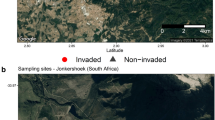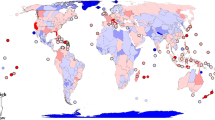Abstract
Ecological impacts associated with ant introductions have received considerable attention, but most studies that report on these impacts contrast species assemblages between invaded and uninvaded sites. Given the low inferential power of this type of space-for-time comparison, alternative approaches are needed to evaluate claims that ant invasions drive native species loss. Here, we use long-term data sets from two different Argentine ant eradication programs on the California Channel Islands to examine how the richness and composition of native ant assemblages change before and after invasion (but prior to the initiation of treatments). At four different sites on two different islands, pre-invasion native ant assemblages closely resembled those at uninvaded (control) sites in terms of species richness, species composition, and the presence of multiple indicator species. Invader arrival coincided with large (> 75%) and rapid (within 1 year) declines in species richness, shifts in species composition, and the loss of indicator species. These impacts will hopefully be reversed by the recolonization of formerly invaded areas by native ant species following Argentine ant treatment, and long-term studies of native ant recovery at these sites are ongoing. Unchecked spread of the Argentine ant on other islands in this archipelago, however, poses a grave threat to native ants, which include a number of endemic taxa.


Similar content being viewed by others
References
Anderson MJ, Crist TO, Chase JM, Vellend M, Inouye BD, Freestone AL, Sanders NJ, Cornell HV, Comita LS, Davies KF, Harrison SP, Kraft NJB, Stegen JC, Swenson NG (2011) Navigating the multiple meanings of β diversity: a roadmap for the practicing ecologist. Ecol Lett 14:19–28
Bellard C, Cassey P, Blackburn TM (2016) Alien species as a driver of recent extinctions. Biol Lett 12:20150623
Beltran RS, Kreidler N, Van Vuren DH, Morrison SA, Zavaleta ES, Newton K, Tershy BR, Croll DA (2014) Passive recovery of vegetation after herbivore eradication on Santa Cruz Island, California. Restor Ecol 22:790–797
Bestelmeyer BT, Agosti D, Alonso LE, Brandao CRF, Brown WL, Delabie JHC, Silvestre R (2000) Field techniques for the study of ground-dwelling ants: an overview, description, and evaluation. In: Agosti D, Majer JD, Alonso LE, Schultz TR (eds) Ants: standard methods for measuring and monitoring biodiversity. Smithsonian Institution, Washington, DC, pp 122–144
Boser CL, Hanna C, Holway DA, Faulkner KR, Naughton I, Merrill K, Randall JM, Cory C, Morrison SA (2017) Protocols for Argentine ant eradication in conservation areas. J Appl Entomol 141:540–550
Boser CL, Merrill KC, Fisher RN, Naughton I, Holway DA (2018) The introduced Argentine ant (Linepithema humile) on the California Channel Islands: distribution and patterns of spread. Monogr Western North Am Nat 78:820–828
Cameron EK, Vilà M, Cabeza M (2016) Global meta-analysis of the impacts of terrestrial invertebrate invaders on species, communities and ecosystems. Glob Ecol Biogeogr 25:596–606
Crowell KL (1968) Rates of competitive exclusion by the Argentine ant in Bermuda. Ecology 49:551–555
Didham RK, Tylianakis JM, Hutchison MA, Ewers RM, Gemmell NJ (2005) Are invasive species the drivers of ecological change? Trends Ecol Evol 20:470–474
Dufrêne M, Legendre P (1997) Species assemblages and indicator species: the need for a flexible asymmetrical approach. Ecol Monogr 67:345–366
Erickson JM (1971) The displacement of native ant species by the introduced Argentine ant Iridomyrmex humilis Mayr. Psyche 78:257–266
Estany-Tigerström D, Bas JM, Pons P (2010) Does Argentine ant invasion affect prey availability for foliage-gleaning birds? Biol Invasions 12:827–839
Hanna C, Naughton I, Boser CL, Holway DA (2015) Testing the effects of ant invasions on non-ant arthropods with high-resolution taxonomic data. Ecol Appl 25:1841–1850
Hoffmann BD, Parr K (2008) An invasion revisited: the African big-headed ant (Pheidole megacephala) in northern Australia. Biol Invasions 10:1171–1181
Hoffmann BD, Andersen AN, Hill GJE (1999) Impact of an introduced ant on native rain forest invertebrates: Pheidole megacephala in monsoonal Australia. Oecologia 120:595–604
Holway DA (1998a) Effect of Argentine ant invasions on ground-dwelling arthropods in Northern California riparian woodlands. Oecologia 116:252–258
Holway DA (1998b) Factors governing rate of invasion: a natural experiment using Argentine ants. Oecologia 115:206–212
Holway DA (1999) Competitive mechanisms underlying the displacement of native ants by the invasive Argentine ant. Ecology 80:238–251
Holway DA (2005) Edge effects of an invasive species across a natural ecological boundary. Biol Conserv 121:561–567
Holway DA, Lach L, Suarez AV, Tsutsui ND, Case TJ (2002) The causes and consequences of ant invasions. Annu Rev Ecol Syst 33:181–233
Human KG, Gordon DM (1996) Exploitation and interference competition between the invasive Argentine ant, Linepithema humile, and native ant species. Oecologia 105:405–412
Human KG, Gordon DM (1997) Effects of Argentine ants on invertebrate biodiversity in northern California. Conserv Biol 11:1242–1248
Kaspari M, Majer JD (2000) Using ants to monitor environmental change. In: Agosti D, Majer JD, Alonso LE, Schultz TR (eds) Ants: standard methods for measuring and monitoring biodiversity. Smithsonian Institution, Washington, DC, pp 89–98
Knapp RA, Matthews KR, Sarnelle O (2001) Resistance and resilience of alpine lake fauna to fish introductions. Ecol Monogr 71:401–421
Krushelnycky PD, Gillespie RG (2010) Sampling across space and time to validate natural experiments: an example with ant invasions in Hawaii. Biol Invasions 12:643–655
Kumschick S, Gaertner M, Vilà M, Essi F, Jeschke JM, Pysek P, Ricciardi A, Bacher S, Blackburn TM, Dick JTA, Evans T, Hulme PE, Kuhn I, Mrugala A, Pergi J, Rabitsch W, Richardson DM, Sendek A, Winter M (2014) Ecological impacts of alien species: quantification, scope, caveats, and recommendations. Bioscience 65:55–63
Lach L (2007) A mutualism with a native membracid facilitates pollinator displacement by Argentine ants. Ecology 88:1994–2004
Lach L, Parr CL, Abbott KL (eds) (2010) Ant ecology. Oxford University Press, Oxford
Lawton JH, Bignel DE, Bolton B, Bloemers GF, Eggleton P, Hammond PM, Hodda M, Holt RD, Larsenk TB, Mawdsley NA, Stork NE, Srivastava DS, Watt AD (1997) Biodiversity inventories, indicator taxa and effects of habitat modification in tropical forest. Nature 391:72–76
LeBrun EG, Abbott J, Gilbert LE (2013) Imported crazy ant displaces imported fire ant, reduces and homogenizes grassland ant and arthropod assemblages. Biol Invasions 15:2429–2442
Liu C, Guénard B, Blachard B, Peng Y-Q, Economo EP (2016) Reorganization of taxonomic, functional, and phylogenetic ant biodiversity after conversion to rubber plantation. Ecol Monogr 86:215–227
Majer JD, Nichols OG (1998) Long-term recolonization patterns of ants in Western Australian rehabilitated bauxite mines with reference to their use as indicators of restoration success. J Appl Ecol 35:161–182
Menke AS, Miller DR (eds) (1985) Entomology of the California Channel Islands. In: Proceedings of the first symposium. Santa Barbara Museum of Natural History, Santa Barbara, CA
Menke SB, Fisher RN, Jetz W, Holway DA (2007) Biotic and abiotic controls of Argentine ant invasion success at local and landscape scales. Ecology 88:3164–3175
Menke SB, Ward PS, Holway DA (2018) Long-term record of Argentine ant invasions reveals enduring ecological impacts. Ecology 99:1194–1202
Merrill KC, Boser CL, Hanna C, Holway DA, Naughton I, Cho D-H, Wilson Rankin EE (2018) Argentine Ant (Linepithema humile, Mayr) eradication efforts on San Clemente Island, CA, USA. Monogr Western North Am Nat 78:829–836
Mitrovich MJ, Matsuda T, Pease KH, Fisher RN (2010) Ants as a measure of effectiveness of habitat conservation planning in Southern California. Conserv Biol 24:1239–1248
Oksanen J, Guillaume Blanchet F, Kindt R, Legendre P, Minchin PR, O’Hara RB, Simpson GL, Solymos P, Henry M, Stevens H, Wagner H (2012) vegan: Community Ecology Package. R package version 2.0-4. http://CRAN.R-project.org/package=vegan
Osenberg CW, Bolker BM, White JS, St. Mary CM, Shima JS (2006) Statistical issues and study design in ecological restorations: lessons learned from marine reserves. In: Falk DA, Palmer MA, Zedler L (eds) Foundations of restoration ecology. Island Press, Washington, DC, pp 280–302
Porter SD, Van Eimeren B, Gilbert LE (1988) Invasion of red imported fire ants (Hymenoptera: Formicidae): microgeography of competitive replacement. Ann Entomol Soc Am 81:913–918
Rick TC, Sillett TS, Ghalambor CK, Hofman CA, Ralls K, Anderson RS, Boser CL, Braje TJ, Cayan DR, Chesser RT, Collins PW, Erlandson JM, Faulkner KR, Fleischer R, Funk WC, Galipeau R, Huston A, King J, Laughrin L, Maldonado J, McEachern K, Muhs DR, Newsome SD, Reeder-Myers L, Still C, Morrison SA (2014) Ecological change on California’s Channel Islands from the Pleistocene to the Anthropocene. Bioscience 64:680–692
Roberts DW (2012) labdsv: ordination and multivariate analysis for ecology. R package version 1.5-0. http://CRAN.R-project.org/package=labdsv
R Core Team (2016) R: A language and environment for statistical computing. R Foundation for Statistical Computing, Vienna, Austria. ISBN 3-900051-07-0. http://www.R-project.org/
Sanders NJ, Gotelli NJ, Heller N, Gordon DM (2003) Community disassembly by an invasive ant species. Proc Natl Acad Sci 100:2474–2477
Suarez AV, Bolger DT, Case TJ (1998) Effects of fragmentation and invasion on native ant communities in coastal southern California. Ecology 79:2041–2056
Tillberg CV, Holway DA, LeBrun EG, Suarez AV (2007) Trophic ecology of Argentine ants in their native and introduced ranges. Proc Natl Acad Sci 104:20856–20861
Tremper BS (1976) Distribution of the Argentine ant, Iridomyrmex humilis Mayr, in relation to certain native ants in California: ecological, physiological, and behavioral aspects. PhD Dissertation, University of California, Berkeley
Underwood EC, Fisher BL (2006) The role of ants in conservation monitoring: if, when, and how. Biol Conserv 132:166–182
Ward PS (1987) Distribution of the introduced Argentine ant (Iridomyrmex humilis) in natural habitats of the lower Sacramento Valley and its effects on the indigenous ant fauna. Hilgardia 55(2):1–16
Wetterer JK, Ward PS, Wetterer AL, Longino JT, Trager JC, Miller SE (2000) Ants (Hymenoptera: Formicidae) of Santa Cruz Island, California. Bull Southern Calif Acad Sci 99:25–31
Zee J, Holway DA (2006) Nest raiding by the invasive Argentine ant on colonies of the harvester ant, Pogonomymex subnitidus. Insectes Soc 53:161–167
Acknowledgements
Funding for this research was provided by The Nature Conservancy (DAH), US Navy (DAH), California Coastal Conservancy (DAH), National Science Foundation Long-term Research in Environmental Biology 1654525 (DAH and NDT) and US Department of Agriculture National Institute of Food and Agriculture Hatch project CA-B-INS-0087-H (NDT). We acknowledge The Nature Conservancy, Channel Islands National Park, US Navy, and University of California Natural Reserve System for granting access to field sites. The following people provided invaluable help and logistical support: M Booker, A Chisholm, D Dewey, K Faulkner, C Gagorik, C Hanna, A Hebshi, W Hoyer, L Laughrin, K Merrill, J Randall, and V Vartanian. M Booker, W Hoyer, EG Le Brun, AV Suarez, and three anonymous reviewers offered helpful comments on the manuscript.
Author information
Authors and Affiliations
Corresponding author
Additional information
Publisher's Note
Springer Nature remains neutral with regard to jurisdictional claims in published maps and institutional affiliations.
Rights and permissions
About this article
Cite this article
Naughton, I., Boser, C., Tsutsui, N.D. et al. Direct evidence of native ant displacement by the Argentine ant in island ecosystems. Biol Invasions 22, 681–691 (2020). https://doi.org/10.1007/s10530-019-02121-7
Received:
Accepted:
Published:
Issue Date:
DOI: https://doi.org/10.1007/s10530-019-02121-7




